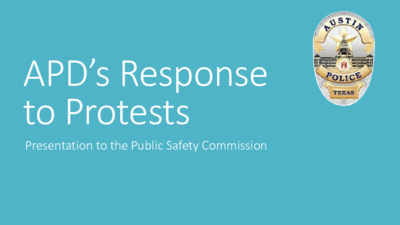Item #5-APD's Response to Protests Presentation-8-1-2022 — original pdf
Backup

APD’s Response to Protests Presentation to the Public Safety Commission Topics Covered • APD’s policies regarding protests • Tactics used at protests • Arrest policies APD GO 408: Mobile Field Force The activation of a MFF should be considered when dealing with any: 1. Large scale disturbance 2. Disturbance where there is potential for escalation of violence if a large scale show of force is not present. APD GO 408: Mobile Field Force The following personnel have the authority to activate a MFF response: 1. Chief of Police 2. Assistant chiefs 3. Commanders 4. Watch Lieutenant 5. Patrol and support lieutenants APD GO 408: Mobile Field Force The Mobile Field Force (MFF) is an organized group of specially trained and disciplined officers that can vary in size depending on the scale of the situation. The objectives of the MFF are to: a) Life/Safety Incident Stabilization b) c) Property Protection d) Societal Restoration APD GO 408: Mobile Field Force The MFF will be equipped with: • Batons or PR24's (excluding ASPs) • OC spray • Less-lethal shotguns • Helmets with face shields Less-Lethal & Non-Lethal Weapons Less-Lethal: 40mm foam baton launcher ***(APD no longer utilizes the 12 gauge bean bag shotgun during crowd control events)*** Non-Lethal: PepperBall launcher Pepper spray APD GO 408: Mobile Field Force The MFF activation will utilize a tiered response plan: 1. Tier I Response - Two designated officers from each on-duty patrol shift respond to a MFF call up. 2. Tier II Response - Officers from the Highway Enforcement Command (Motors, L&W, and Highway Response) respond to a MFF call up, and they can be supplemented by additional officers from patrol or other Department units Tactics The control strategies employed by the MFF include: a) Emergency Response b) Containment c) Arrest d) Local Emergency Orders Emergency Response A major civil disorder will require the Department to devote a large portion of its resources to restore order. When circumstances indicate that such a response is required, the Incident Commander will announce the mobilization of the MFF and will give the location of the assembly area. All specified personnel will respond to the designated location. Containment The three basic concepts of perimeter control are: 1. Linear Strategy - Deploys police as a blocking force along a roadway or geographic barrier perpendicular to access routes into the area. 2. Cordoning - Surrounds a particular problem area by using the linear strategy to seal off access on all sides. These two maneuvers prevent outsiders from being drawn into the unrest as victims or participants and, at the same time, limit the spread of violence. 3. Sectoring - Divides the cordoned area into smaller sized units. Order can be restored one sector at a time as sufficient police resources are assembled. Local Emergency Orders An essential component of the Department's strategy for responding to a civil disorder is the issuance of emergency orders. The Mayor has the authority to issue and enforce rules, regulations, orders, and directions necessary to maintain Life Safety, Incident Stabilization, Property Conservation, and Societal Restoration (e.g., establish a curfew). Local Emergency Orders • Traditional PA device in patrol cars is inadequate in a large demonstration. • The Long Range Acoustic Device (LRAD) is used to communicate to large crowds. • The LRAD is used ONLY for giving verbal announcements to crowds. The LRAD ensures that everyone is able to hear communications from officers. Arrests During acts of civil disorder, police must act quickly to arrest violators of the law. These arrests will help diffuse the unrest while also providing a break in the violence. a) Arrests must commence from the outset and be made early, quickly, constitutionally, fairly, and reasonably. This pattern must be sustained for the duration of the unrest. If mass arrests occur, the Incident Commander will request prisoner transport vehicles to the scene. b) Arrests • During protests, arrests occur the same as they would occur in a patrol setting. • During protests, prisoners are usually transported in a prisoner transport van. Special circumstances require a patrol car be utilized to transport. • All arrests have their own case number. • Males & females are separated for transport. • Juvenile arrestees are kept separate from adults. Arrest Policies Suspects being arrested and transported in police vehicles shall be handcuffed or otherwise restrained as described below: 1. Prisoners will generally be restrained with hands behind the back. If handcuffs are used, they shall be double locked. In case of advanced age, injury, physical disability, or other circumstances where arrested persons are incapable of placing their hands behind their back, the officer may: 2. a) b) c) Use flex cuffs Apply handcuffs with the hands to the front Choose not to use a restraining device. If the prisoner is not restrained, two officers should be used to transport the prisoner as safely as possible. Intelligence • Monitor local and national media for any issues that could initiate protests in Austin. • Monitor permits filed with the city for groups looking to conduct demonstrations. • Make contact with protest organizers to discuss how they and APD can work together to ensure a safe event for all attendees. • Coordinate with other agencies for any information they give regarding potential protests in the Austin area. Questions?